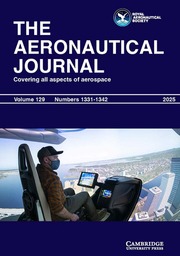No CrossRef data available.
Article contents
Viscous contribution to the high Machnumber damping in pitch of blunt slender cones atsmall angles of attack
Published online by Cambridge University Press: 04 July 2016
Summary
The dynamic stability derivatives of blunt cones forsmall variations in angles of attack have beenpreviously derived by the current author. However,no account of the unsteady nature of the boundarylayer was made in that work. In this paper closedform expressions for the increment in dynamicstability due to the presence of the boundary layerare derived by considering the pressure distributionperturbations as the boundary layer continuouslyadjusts to the enclosed oscillating body. The theoryprovides a first hand estimate of the complete pitchderivative damping without having to resort to morerigorous and expensive computational methods.Calculations performed at Mach numbers of 7 to 10with axis positions ranging from 0·5 to 0·7 of thechord length for cones of semi-angle 10° and 20°,indicate that the effect of boundary layer is toslightly reduce the magnitude of the invisciddamping derivative. For blunt cones at angles ofattack less than 5°, this was in good agreement withthe limited experimental data available.
Information
- Type
- Research Article
- Information
- Copyright
- Copyright © Royal Aeronautical Society 1995

